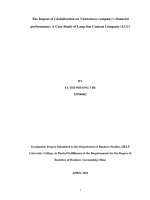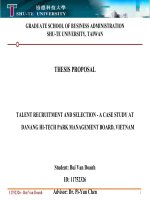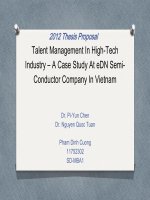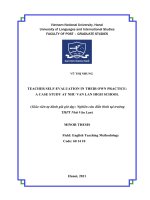Talent Management In High-Tech Industry – A Case Study At eDN Semi- Conductor Company In Vietnam
Bạn đang xem bản rút gọn của tài liệu. Xem và tải ngay bản đầy đủ của tài liệu tại đây (13.08 MB, 33 trang )
Talent Management In High-Tech
Industry – A Case Study At eDN Semi-
Conductor Company In Vietnam
Dr. Pi-Yun Chen
Dr. Nguyen Quoc Tuan
Pham Dinh Cuong
11752302
SD-MBA1
2012 Thesis Proposal
Keywords
•
Semi-conductor Industry in Vietnam
•
Employee Recruitment
•
Employee Retention
•
Talent
•
Talent Management
Outlines
1.
Introduction
2.
Literature Review
3.
Research Methods
4.
Concluding Remarks
1.Introduction (1/11)
•
Research Background (1/7)
•
Semi-conductor Industry was recognized around
1830s. However the industry has just been in
fast development since 1960s when Jack Kilby
successfully put several devices fabricated in one
Silicon subtract.
•
It is now widely recognized as a key driver for
economic growth, more and more governments have
supported financial and encouraged it growing in
their country.
•
According to Gartner’s report, Worldwide
Semiconductor Revenue Reached $307 Billion in
2011.
1.Introduction (2/11)
•
Research Background (2/7)
•
65% executives and managers report that they’ve insufficient
top talent in the ranks of their top 300 leaders, whereas
only 10% say that their companies can retain most of their
high performers (Michaels, Handfield-Jones, & Axelrod,
2001; Ready & Conger, 2007).
•
There are very few individuals within each industry who are
considered top human capital (Allen, Bryant, & Vardaman,
2010). Top performers generate a great deal of revenues,
profit, and overall success for their company (O’Boyle &
Aguinis, 2012).
•
The company will be lead to the talent war with other companies
to (1) retain top talent, (2) hire away top talent from other
companies (Fishman, 1998).
1.Introduction (3/11)
•
Research Background (3/7)
•
In Vietnam, since 2003, numerous Laws and Decisions
related to High-Tech industry have been issued, it shows the
effort and target of the government in developing the Industry
in Vietnam and realizing the target to be an industrialized
country in 2020.
•
Following the Laws and Decisions, some small Semi-
conductor companies had been established and operated by
Oversea Vietnamese like Silicon Design Solutions Vietnam,
Array Technologies Vietnam. And then big companies and
design centers have been established
1.Introduction (4/11)
•
Research Background (4/7)
•
October 2004, Renesas Electronic, Inc, a Global Semi-
conductor Company established their design center in
Vietnam, called Renesas Design Vietnam Co.
•
August 2005, Integrated Circuit Design Research &
Education Center (ICDREC) was established with the
purposes are (1) to be a training center for Integrated
Circuit Design, (2) to have well research works and articles
will be known by national and international scientist,
(3) transferring technology by carrying out outsourcing
contracts with local and foreign business.
1.Introduction (5/11)
•
Research Background (5/7)
•
October 2010 Intel opened a billion-dollar plant in Vietnam,
the company's biggest in the world, focusing on testing and
assembly expected to create thousands of skilled jobs in
high-tech manufacturing and generate significant export
revenues for the country.
•
Beside these big ones, there are such small ones operating
in the industry. Most of them are located in Ho Chi Minh
City, there are few of them located in Hanoi or Danang City.
All these companies are either established by Oversea
Vietnamese or subsidiary/design centers of a global
company.
1.Introduction (6/11)
•
Research Background (6/7)
•
Vietnam Semi-conductor companies
•
Play key role for the growth of this young industry in Vietnam
•
Operate under the global management with specific specialization
to align with Vietnam’s culture.
•
Their employees
•
Domestic Universities, Oversea study or Experts from other
countries.
•
Knowledge levels are also different from bachelor to doctor.
•
They bring in specialized knowledge and cultures to grow the
company
•
But they also bring in different working styles, expectations
and perspectives which lead the firm to be difficult to manage,
align and satisfy them to motive their employees.
1.Introduction (7/11)
•
Research Background (7/7)
•
Navigos Search, a department of Navigos Group, Ltd did a
research on employee’s satisfaction in Vietnam by the first
quarter of 2011.
•
With 4,800 employees of 50 companies in Vietnam
•
Questions were focusing on key factors to attract and keep excellent
employees to stay with the company
•
The result shows
•
76% employees choose good management Team as their 1
st
preferring
•
75,2% employees choose good working environment as their 2
nd
preferring
•
71.8% employees choose employee education as their 3
rd
preferring
•
66,4% employees choose salary and bonus as their 4
th
preferring
•
It shows that the salary and bonus is not the 1
st
factor to attract the
employees.
1.Introduction (8/11)
•
Research Motive (1/2)
•
Vietnam government have been issued numerous Laws
and Decisions to encourage and support High-Tech
industries. Where Law N0.21/2008/QH12 dated 11/13/2008
on High Tech technology defines Information Technology,
including Semi-conductor as one of the prioritized domain for
development
•
More Semi-conductor companies have been established in
Vietnam but there are not enough talents in this field so new
companies tend to attract and recruit existing employees.
There will be a talent war between companies to attract,
recruit and retain the talent employees. Attracting and
retaining employees becomes critical.
1.Introduction (9/11)
•
Research Motive (2/2)
•
This industry is new in Vietnam. Working culture of
Vietnamese is different with the others in the world. It
is important for the company to understand key factors
impacted to the motivation, performance and expectation of
their employees
•
There are researches on talent management in the world but
there is less research on talent management in Vietnam.
•
A research on talent management is to support the company
to improve their resource management strategy to attract,
recruit and retain the employees
1.Introduction (10/11)
•
Research Purpose (1/1)
•
To understand the expectation and perspective of
the employees
•
To understand the talent management strategy of
the company
•
To understand the gap between the talent
management strategy of the company and the
expectation and perspective of the employee.
•
To propose solutions to get closer between the
company and the employee
1. Introduction (11/11)
Research Objective
Literature Review
Qualitative Research
Data Analysis
Conclusion & Suggestion
•
Research Procedure (1/1)
Design
Questions
Interview
2.Literature Reviews (1/5)
•
Semi-conductor Industry in Vietnam
•
The industry has been established around 2000s. Around
2000s, Oversea Vietnamese comeback to Vietnam and
established small design centers operating on Integrated Circuit
designs.
•
Since 2003 to 2010, Vietnam government issues numerous
Laws and Decisions to encourage investments in High-Tech
Industry, including Semi-conductor Industry. As the result,
large Semi-conductor companies in the world have invested to
Vietnam by establishing Design Centers. In parallel with that,
such small companies also established.
•
Most of the companies are either a subsidiary or design centers
of global companies, or they are established by Oversea
Vietnamese
2.Literature Reviews (2/5)
•
Employee Recruitment
•
According to Michael, A., Armstrong’s Handbook
of Human Resource Management Practice,
Recruitment is the process of finding and engaging
the people the company needs. The recruitment
will run through 4 stages:
•
Defining requirements
•
Planning recruitment campaigns.
•
Attracting candidates
•
Selecting candidates
2.Literature Reviews (3/5)
•
Employee Retention
•
It is the strategy of the company to retain
its employees. According to Michael,
A., Armstrong’s Handbook of Human
Resource Management Practice, the
strategies should be based on an
understanding of the factors that affect
whether or not the employees leave or stay
2.Literature Reviews (4/5)
•
Talent
•
While doing literature review, there are several definitions
for the talent. However in this research, the talent is
defined as below based on the CIPD (2007f)
“Talent consists of those individuals who can make a
difference to organizational performance, either through
their immediate contribution or in a longer term by
demonstrating the highest levels of potential”
•
The organization leads the talent war with other companies
to attract, recruit and retain talented peoples
2.Literature Reviews (5/5)
•
Talent Management
•
Literature review also shows various
definitions for the talent management, however
in this research, Talent management is defined
as below (Michael, A., Armstrong’s Handbook
of Human Resource Management Practice,
11
th
, Kogan Page).
“Talent management is the process of identifying,
developing, recruiting and deploying talents.”
3.Research Methods (1/11)
•
Case study company (1/2)
•
Case study company is a Global Semi-Conductor company.
The company has head-quarter in USA, and design centers
around the world: North America, Europe (England, Spain
and Romania), Asia (China, Korea, Singapore and Vietnam).
The research will focus on their design center in Vietnam.
•
The company operating can reflect global – local
management, multi-levels of engineers, multi-cultures, cross-
working between centers… It reflects the model of most of
Global Semi-Conductor companies
BOD
HR Dept. Engineering Dept.
Digital Dept.
Team Leader
Project Leader
Engineer
AMS Dept.
Team Leader
Project Leader
Engineer
Individual
Contributor
ASIC Dept.
Team Leader
Project Leader
Engineer
Finance Dept.
3. Research Methods (2/
11)
•
Case Study Company (2/2)
•
AMS: Analog-Mixed Signal
•
ASIC: Application Specific Integrated Circuit
3.Research Methods (3/11)
•
Qualitative method will be used by interviewing
employees of a semi-conductor company in
Danang city, Vietnam
•
In-depth interview with semi-structured questions
3.Research Methods (4/11)
•
Interviewed Target: 18 Interviewees representing for all
departments and Teams in the company
•
3 Human Resource Managers
•
3 Team Leaders representing 3 Engineering departments
inside the company
•
3 Project Leaders representing 3 above departments.
•
3 Individual Contributors
•
6 Engineers (2 engineers for each Engineering
department)
3.Research Methods (5/11)
•
Question Design
•
Business Research Method, Dr. Pi-Yun Chen
•
Creswell, J. W., & Plano Clark, V. Principles
of qualitative research: Designing a qualitative
study
3.Research Methods (6/11)
•
Theoretical Basis (1/2)
•
Herman, Ryan, &Harry suggest using
performance management to win the talent
war by 4 factors below:
•
Individualized developmental plans
•
Challenging, interesting and meaningful work
•
Advancement opportunities
•
Contingent rewards









